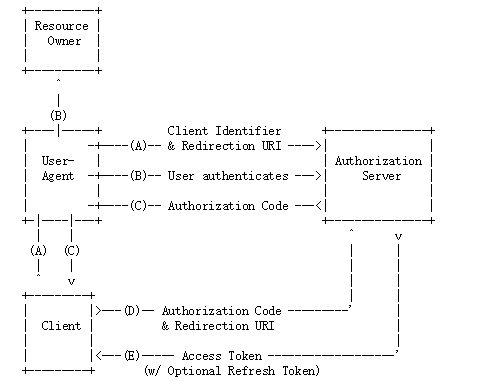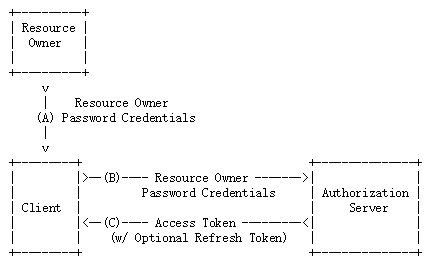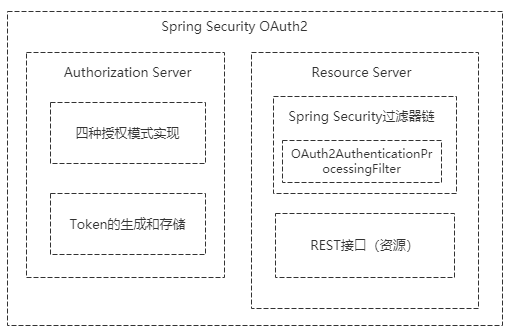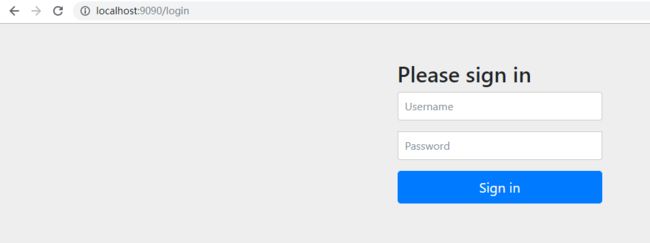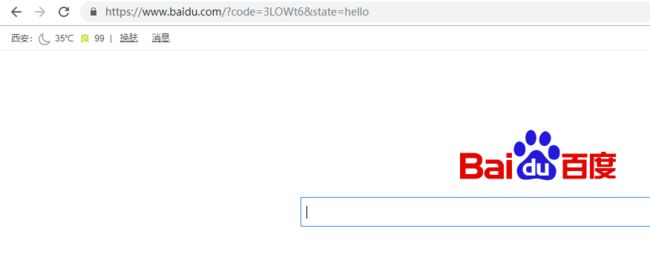OAuth是一种用来规范令牌(Token)发放的授权机制,主要包含了四种授权模式:授权码模式、简化模式、密码模式和客户端模式。Spring Security OAuth2对这四种授权模式进行了实现。这节主要记录下什么是OAuth2以及Spring Security OAuth2的基本使用。
下面分为二部分讲解:
- 四种授权模式
1.1 授权码模式
1.2 密码模式 - SpringSecurity OAuth2 Demo
2.1 配置认证服务器
2.2 授权码模式获取令牌
2.3 密码模式获取令牌
2.4 配置资源服务器
四种授权模式
在了解这四种授权模式之前,我们需要先学习一些和OAuth相关的名词。举个社交登录的例子吧,比如在浏览器上使用微信账号登录,这个过程可以提取出以下几个名词:
Third-party application 第三方应用程序,比如这里的
HTTP service HTTP服务提供商,比如这里的微信
Resource Owner 资源所有者,就是微信用户,你
User Agent 用户代理,这里指浏览器
Authorization server 认证服务器,这里指微信提供的第三方登录服务
Resource server 资源服务器
授权模式
授权码模式是最能体现OAuth2协议,最严格,流程最完整的授权模式,流程如下所示:
A. 客户端将用户导向认证服务器;
B. 用户决定是否给客户端授权;
C. 同意授权后,认证服务器将用户导向客户端提供的URL,并附上授权码;
D. 客户端通过重定向URL和授权码到认证服务器换取令牌;
E. 校验无误后发放令牌。
其中A步骤,客户端申请认证的URI,包含以下参数:
response_type:表示授权类型,必选项,此处的值固定为”code”,标识授权码模式
client_id:表示客户端的ID,必选项
redirect_uri:表示重定向URI,可选项
scope:表示申请的权限范围,可选项
state:表示客户端的当前状态,可以指定任意值,认证服务器会原封不动地返回这个值。
D步骤中,客户端向认证服务器申请令牌的HTTP请求,包含以下参数:
grant_type:表示使用的授权模式,必选项,此处的值固定为”authorization_code”。
code:表示上一步获得的授权码,必选项。
redirect_uri:表示重定向URI,必选项,且必须与A步骤中的该参数值保持一致。
client_id:表示客户端ID,必选项。
密码模式
在密码模式中,用户向客户端提供用户名和密码,客户端通过用户名和密码到认证服务器获取令牌。流程如下所示:
A. 用户向客户端提供用户名和密码;
B. 客户端向认证服务器换取令牌;
C. 发放令牌。
B步骤中,客户端发出的HTTP请求,包含以下参数:
grant_type:表示授权类型,此处的值固定为”password”,必选项。
username:表示用户名,必选项。
password:表示用户的密码,必选项。
scope:表示权限范围,可选项。
SpringSecurity OAuth2 Demo
Spring框架对OAuth2协议进行了实现,下面学习下上面两种模式在Spring Security OAuth2相关框架的使用。
Spring Security OAuth2主要包含认证服务器和资源服务器这两大块的实现:
认证服务器主要包含了四种授权模式的实现和Token的生成与存储,我们也可以在认证服务器中自定义获取Token的方式(后面会介绍到);资源服务器主要是在Spring Security的过滤器链上加了OAuth2AuthenticationProcessingFilter过滤器,即使用OAuth2协议发放令牌认证的方式来保护我们的资源。
配置认证服务器
新建一个SpringBoot 项目,版本为2.1.6.RELEASE并引入相关依赖,pom如下:
4.0.0
org.springframework.boot
spring-boot-starter-parent
2.1.6.RELEASE
top.lconcise
Spring-Security-OAuth2-Guide
0.0.1-SNAPSHOT
Spring-Security-OAuth2-Guide
Demo project for Spring Boot
1.8
org.springframework.boot
spring-boot-starter-security
org.springframework.boot
spring-boot-starter-web
org.springframework.cloud
spring-cloud-starter
org.springframework.cloud
spring-cloud-starter-oauth2
org.springframework.cloud
spring-cloud-starter-security
org.apache.commons
commons-lang3
org.projectlombok
lombok
1.18.8
provided
org.springframework.boot
spring-boot-starter-test
test
org.springframework.security
spring-security-test
test
org.springframework.boot
spring-boot-maven-plugin
在创建认证服务器前,我们先定义一个MyUser对象:
@Data
public class MyUser implements Serializable {
private static final long serialVersionUID = 3497935890426858541L;
private String userName;
private String password;
private boolean accountNonExpired = true;
private boolean accountNonLocked= true;
private boolean credentialsNonExpired= true;
private boolean enabled= true;
}
接着定义UserDetailService实现org.springframework.security.core.userdetails.UserDetailsService接口:
@Service
public class UserDetailService implements UserDetailsService {
@Autowired
private PasswordEncoder passwordEncoder;
@Override
public UserDetails loadUserByUsername(String username) throws UsernameNotFoundException {
MyUser user = new MyUser();
user.setUserName(username);
user.setPassword(this.passwordEncoder.encode("123456"));
return new User(username, user.getPassword(), user.isEnabled(),
user.isAccountNonExpired(), user.isCredentialsNonExpired(),
user.isAccountNonLocked(), AuthorityUtils.commaSeparatedStringToAuthorityList("admin"));
}
}
这里的逻辑是用什么账号登录都可以,但是密码必须为123456,并且拥有”admin”权限。
接下来开始创建一个认证服务器,并且在里面定义UserDetailService需要用到的PasswordEncoder。
创建认证服务器很简单,只需要在Spring Security的配置类上使用@EnableAuthorizationServer注解标注即可。创建AuthorizationServerConfig,代码如下所示:
@Configuration
@EnableAuthorizationServer
public class AuthorizationServerConfig extends WebSecurityConfigurerAdapter {
@Bean
public PasswordEncoder passwordEncoder() {
return new BCryptPasswordEncoder();
}
}
这时候启动项目,会发现控制台打印出了随机分配的client-id和client-secret:
security.oauth2.client.client-id = 4afe5cf8-23e0-406f-8ed4-e80db6ef63f1
security.oauth2.client.client-secret = f7e63ad5-327c-4b97-b280-27432bfd0383
为了方便后面的测试,我们可以手动指定这两个值。在Spring Boot配置文件application.yml中添加如下配置:
security:
oauth2:
client:
client-id: test
client-secret: test1234
重启项目,发现控制台输出:
security.oauth2.client.client-id = test
security.oauth2.client.client-secret = ****
说明替换成功。
授权模式获取令牌
接下来开始往认证服务器请求授权码。打开浏览器,访问http://localhost:9090/oauth/authorize?response_type=code&client_id=test&redirect_uri=https://www.baidu.com&scope=all&state=hello
URL中的几个参数在上面的授权码模式的A步骤里都有详细说明。这里response_type必须为code,表示授权码模式,client_id就是刚刚在配置文件中手动指定的test,redirect_uri这里随便指定一个地址即可,主要是用来重定向获取授权码的,scope指定为all,表示所有权限。
访问这个链接后,页面如下所示:
需要登录认证,根据我们前面定义的UserDetailService逻辑,这里用户名随便输,密码为123456即可。输入后,页面跳转如下所示:
原因是上面指定的redirect_uri必须同时在配置文件中指定,我们往application.yml添加配置:
server:
port: 9090
security:
oauth2:
client:
client-id: test
client-secret: test1234
registered-redirect-uri: https://www.baidu.com
重启项目,重新执行上面的步骤,登录成功后页面成功跳转到了授权页面:
选择同意Approve,然后点击Authorize按钮后,页面跳转到了我们指定的redirect_uri,并且带上了授权码信息:
到这里我们就可以用这个授权码从认证服务器获取令牌Token了。
key为Authentication,value为
Basic加上
client_id:client_secret经过base64加密后的值(可以使用 http://tool.chinaz.com/Tools/Base64.aspx):
源码地址:https://github.com/lbshold/springboot/tree/master/Spring-Security-OAuth2-Guide
参考文章:
https://juejin.im/post/5a3cbce05188252582279467
http://www.ruanyifeng.com/blog/2019/04/oauth_design.html
https://mrbird.cc/Spring-Security-OAuth2-Guide.html
